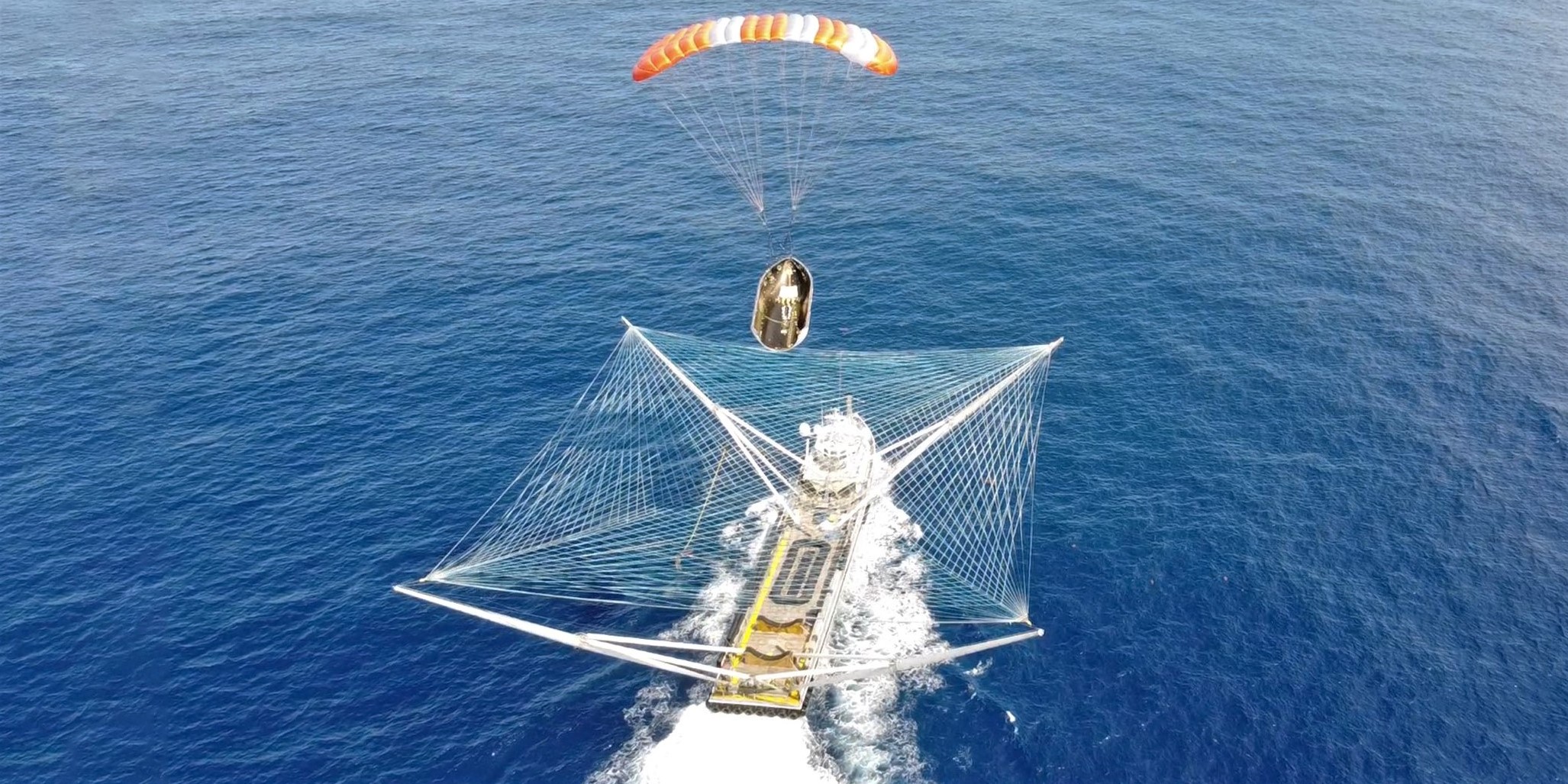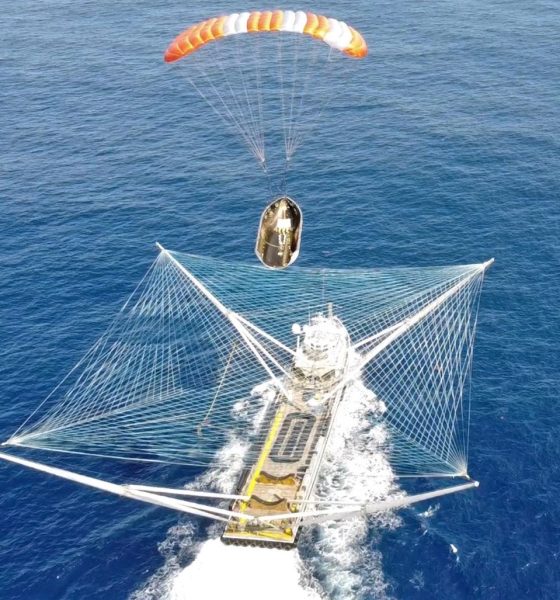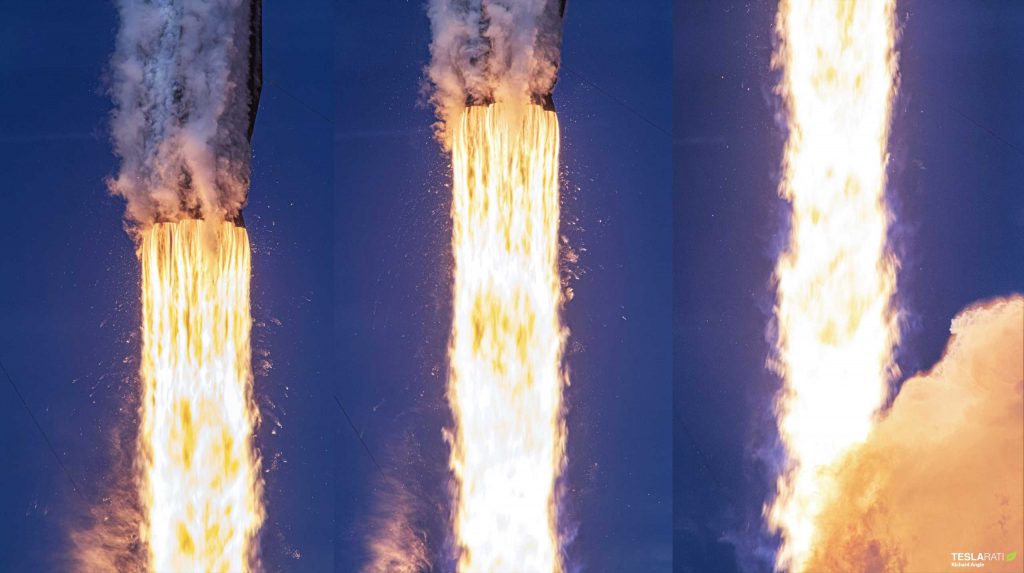

News
SpaceX makes rocket fairing catch look easy with “autopilot” recovery
SpaceX has made Falcon 9 rocket fairing recovery look easy in a video of the latest nosecone catch, published hours after the company’s successful Starlink-10 launch.
Posted on Twitter by Elon Musk not long after a SpaceX webcast host and engineer revealed that one of two fairing catch attempts had been successful, the video offers the best in-action view yet of an operational fairing recovery. Backed by elevator music, it also certainly carries a clear signature of the CEO’s humor, carrying the torch from previous hits like “How Not to Land an Orbital Rocket Booster“, “Grasshopper vs. Cows“, and the successful launch of a Tesla Roadster and spacesuit-wearing mannequin into interplanetary space.
Lackadaisical theme song aside, Musk also shed some light on the actual process of catching Falcon fairings with giant ships and nets. Those new details point towards a major improvement made in the last six or so months that’s helped enable an unprecedented three successful fairing catches in less than 30 days.



According to Musk, SpaceX caught the Starlink-10 fairing half with both recovery ship GO Ms. Tree and the parasailing fairing half “operating on (SpaceX) autopilot.” While his comments leave a great deal of room for interpretation, they seem to imply that SpaceX has found ways to make fairing recovery almost as automatic as Falcon booster landings. During Falcon first stage recovery, the booster and drone ship technically operate as if the other doesn’t exist – the ship simply station keeps in a very specific location and the booster targets that same specific location.
Fairing recovery, as SpaceX would quickly find out, was a dramatically more complex and touchy ballet of humans, machinery, and rocket parts. Little is known about the specifics of fairing recovery beyond the fact that fairing halves have cold gas thrusters for positioning in vacuum and use GPS-guided parafoils to travel towards a rough landing zone. For most prior attempts, it’s believed that one or several crew members were responsible for manually maneuvering the recovery ship during catch attempts.



Including controlled helicopter drop tests, SpaceX failed a dozen or more consecutive fairing catch attempts and even shipped the entire operation from California to Florida before the first successful catch finally came in June 2019. In an apparent fluke, SpaceX managed to catch another fairing half less than two months later. Five months later, SpaceX secured its third fairing catch – possibly the very same fairing half caught on Monday. Another six months after #3, SpaceX hit a major milestone, simultaneously catching both halves of a Falcon fairing with two separate ships on July 21st, 2020.

Now, just 29 days after that spectacular double catch, SpaceX has caught another Falcon 9 fairing half – tempered only by the fact that sister ship Ms. Chief missed her own catch attempt. While it could certainly be a fluke of luck akin to SpaceX’s back-to-back STP-2 and Amos-17 catches, Musk’s note that “fairing chute control & ship control are closing the loop locally” points to cautious optimism.
Cryptic as ever, the comment seems to imply that SpaceX has debuted – or at least recently introduced – a kind of cooperative, autonomous navigation system that allows Falcon fairings and their recovery ships to communicate and function as a unit. For now, we’ll have to wait for the next catch attempt to get a better idea of just how much of a step forward SpaceX has made. SAOCOM 1B, SpaceX’s next Falcon 9 fairing recovery (and launch), is currently scheduled no earlier than (NET) August 27th.
Check out Teslarati’s Marketplace! We offer Tesla accessories, including for the Tesla Cybertruck and Tesla Model 3.

News
Tesla FSD fleet is nearing 7 billion total miles, including 2.5 billion city miles
As can be seen on Tesla’s official FSD webpage, vehicles equipped with the system have now navigated over 6.99 billion miles.

Tesla’s Full Self-Driving (Supervised) fleet is closing in on almost 7 billion total miles driven, as per data posted by the company on its official FSD webpage.
These figures hint at the massive scale of data fueling Tesla’s rapid FSD improvements, which have been quite notable as of late.
FSD mileage milestones
As can be seen on Tesla’s official FSD webpage, vehicles equipped with the system have now navigated over 6.99 billion miles. Tesla owner and avid FSD tester Whole Mars Catalog also shared a screenshot indicating that from the nearly 7 billion miles traveled by the FSD fleet, more than 2.5 billion miles were driven inside cities.
City miles are particularly valuable for complex urban scenarios like unprotected turns, pedestrian interactions, and traffic lights. This is also the difference-maker for FSD, as only complex solutions, such as Waymo’s self-driving taxis, operate similarly on inner-city streets. And even then, incidents such as the San Francisco blackouts have proven challenging for sensor-rich vehicles like Waymos.
Tesla’s data edge
Tesla has a number of advantages in the autonomous vehicle sector, one of which is the size of its fleet and the number of vehicles training FSD on real-world roads. Tesla’s nearly 7 billion FSD miles then allow the company to roll out updates that make its vehicles behave like they are being driven by experienced drivers, even if they are operating on their own.
So notable are Tesla’s improvements to FSD that NVIDIA Director of Robotics Jim Fan, after experiencing FSD v14, noted that the system is the first AI that passes what he described as a “Physical Turing Test.”
“Despite knowing exactly how robot learning works, I still find it magical watching the steering wheel turn by itself. First it feels surreal, next it becomes routine. Then, like the smartphone, taking it away actively hurts. This is how humanity gets rewired and glued to god-like technologies,” Fan wrote in a post on X.
News
Tesla starts showing how FSD will change lives in Europe
Local officials tested the system on narrow country roads and were impressed by FSD’s smooth, human-like driving, with some calling the service a game-changer for everyday life in areas that are far from urban centers.

Tesla has launched Europe’s first public shuttle service using Full Self-Driving (Supervised) in the rural Eifelkreis Bitburg-Prüm region of Germany, demonstrating how the technology can restore independence and mobility for people who struggle with limited transport options.
Local officials tested the system on narrow country roads and were impressed by FSD’s smooth, human-like driving, with some calling the service a game-changer for everyday life in areas that are far from urban centers.
Officials see real impact on rural residents
Arzfeld Mayor Johannes Kuhl and District Administrator Andreas Kruppert personally tested the Tesla shuttle service. This allowed them to see just how well FSD navigated winding lanes and rural roads confidently. Kruppert said, “Autonomous driving sounds like science fiction to many, but we simply see here that it works totally well in rural regions too.” Kuhl, for his part, also noted that FSD “feels like a very experienced driver.”
The pilot complements the area’s “Citizen Bus” program, which provides on-demand rides for elderly residents who can no longer drive themselves. Tesla Europe shared a video of a demonstration of the service, highlighting how FSD gives people their freedom back, even in places where public transport is not as prevalent.
What the Ministry for Economic Affairs and Transport says
Rhineland-Palatinate’s Minister Daniela Schmitt supported the project, praising the collaboration that made this “first of its kind in Europe” possible. As per the ministry, the rural rollout for the service shows FSD’s potential beyond major cities, and it delivers tangible benefits like grocery runs, doctor visits, and social connections for isolated residents.
“Reliable and flexible mobility is especially vital in rural areas. With the launch of a shuttle service using self-driving vehicles (FSD supervised) by Tesla in the Eifelkreis Bitburg-Prüm, an innovative pilot project is now getting underway that complements local community bus services. It is the first project of its kind in Europe.
“The result is a real gain for rural mobility: greater accessibility, more flexibility and tangible benefits for everyday life. A strong signal for innovation, cooperation and future-oriented mobility beyond urban centers,” the ministry wrote in a LinkedIn post.
News
Tesla China quietly posts Robotaxi-related job listing
Tesla China is currently seeking a Low Voltage Electrical Engineer to work on circuit board design for the company’s autonomous vehicles.

Tesla has posted a new job listing in Shanghai explicitly tied to its Robotaxi program, fueling speculation that the company is preparing to launch its dedicated autonomous ride-hailing service in China.
As noted in the listing, Tesla China is currently seeking a Low Voltage Electrical Engineer to work on circuit board design for the company’s autonomous vehicles.
Robotaxi-specific role
The listing, which was shared on social media platform X by industry watcher @tslaming, suggested that Tesla China is looking to fill the role urgently. The job listing itself specifically mentions that the person hired for the role will be working on the Low Voltage Hardware team, which would design the circuit boards that would serve as the nervous system of the Robotaxi.
Key tasks for the role, as indicated in the job listing, include collaboration with PCB layout, firmware, mechanical, program management, and validation teams, among other responsibilities. The role is based in Shanghai.
China Robotaxi launch
China represents a massive potential market for robotaxis, with its dense urban centers and supportive policies in select cities. Tesla has limited permission to roll out FSD in the country, though despite this, its vehicles have been hailed as among the best in the market when it comes to autonomous features. So far, at least, it appears that China supports Tesla’s FSD and Robotaxi rollout.
This was hinted at in November, when Tesla brought the Cybercab to the 8th China International Import Expo (CIIE) in Shanghai, marking the first time that the autonomous two-seater was brought to the Asia-Pacific region. The vehicle, despite not having a release date in China, received a significant amount of interest among the event’s attendees.








